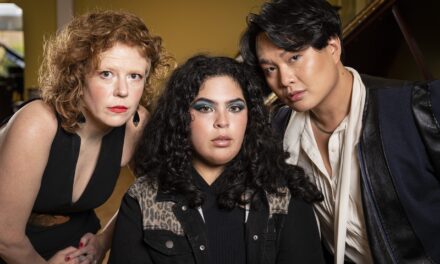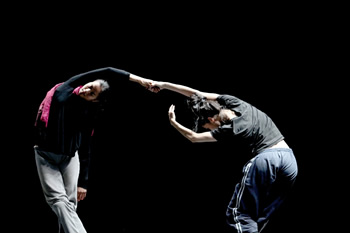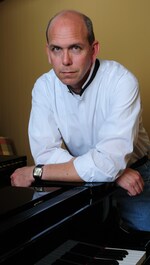Since 2004, when Charlotte Ballet’s satellite company (known then as NCDT2) gave a pair of lunchtime programs at Duke Energy Theatre, no dance company had appeared at the venue until this year. Just by performing there, PLEXUS|dance has proven their uniqueness. In Sophisticated Animal, their third venture at the Duke, they also pushed the envelope in constructing their program, involving the audience, and utilizing the space. Plexus founder Juliana Tilbury-Carson choreographed the four pieces on display, all of them premieres, but which of them we were watching at any given moment could become something of a mystery.
We definitely began with the premiere of “Dusk ’til Dawn,” set to music by Andrew Bird. A serving cart was wheeled out from the wings, laden with bottles, wine glasses, and a small table lamp – the bar at an inn. The bartender (Tilbury), the innkeeper, and her uncle all settled into cocktail-hour movement and conviviality – none of it dancing, really – until the Innkeeper (Julia Bevins Ross) and her Uncle (Daniel Carson) exited through the audience. Or so it seemed from the third row. Moments later, they appeared up in the balcony, taking seats at a cocktail table, equipped with a matching table lamp, above the upstage.
Three of the five dancers listed as Ladies and Gent then began the first dance segment of “Dusk ’til Dawn” – except that it wasn’t. You really needed to be familiar with the music of Bird, Miss Anna Lee & The Authority, Icebreaker, The Black Keys, Handsome Furs, and Carbon Based Lifeforms confidently to determine which premiere was being presented. Thanks to Google, I was able to unravel part of the mystery for certain. The first title I was able to track down was Miss Anna Lee’s racy version of “16 Tons,” so our first sighting of Sarah Ingel, Amanda Rentschler, and Caitlyn Swett was actually in the premiere of Tilbury’s “She.” When we moved further into the program, into the second title I could identify – “Damn You for Being So Easygoing” – my googling revealed that we were listening to Bird’s music. So we had actually circled back to “Dusk ’til Dawn.”
There were actually three music sources listed for “She,” so I presume that when Ingel, Rentschler, and Swett reunited as a trio after intermission, additional segments of the dance were being intercut with “Dusk ’til Dawn,” which proved to be as much a framework for the evening as an original choreography. When the remainder of the Ladies and Gent appeared in their first pas de deux, as soon as the other Ladies had exited, it was easy enough to conclude that we were still in the opening piece, especially since I was unfamiliar with the Handsome Furs’ oeuvre. In retrospect, it seems more likely that Breanne Horne and Eric Mullis were premiering “Trace.” Their reappearance as a romantic duo after intermission seemed to indicate that this dance was also intercut with the framing “Dusk ’til Dawn,” since the backbeat was very similar in the music. I was particularly taken by Horne’s lithe movement and expressiveness, finding her to be the most impressive performer aside from Tilbury herself.
There were multiple solos throughout the program, so it was difficult to determine when exactly I saw the premiere of “Greater Good,” especially since “Abel Costa or Juliana Tilbury” was listed as the soloist. A dip into Carbon Based Lifeforms on my Spotify subscription bolsters my suspicion that “Greater Good,” as danced by Tilbury, was the most arresting – and dramatic – piece of the evening. She first appeared in dim light in black underwear. Then as the eerie music played, she dressed herself in a man’s pants, shirt, and tie, very much in the non-dancing style of the enclosing “Dawn ’til Dusk” piece. Fully dressed, Tilbury emerged into brighter light, perhaps representing her workday. Whatever it was, life in her clothes was not fulfilling, for the necktie became an unmistakable instrument of confinement as the movement shifted into dance. The most haunting image of the piece came when she undressed in the concluding segment of the piece. In the dimmed light, she crawled backwards to the rear curtain, then crawled compulsively toward us and away from us at a manic pace until the final blackout. For me, these last images conjured up scenes from Dracula at the Count’s castle and in Renfield’s asylum cell when these disturbing characters emulate lower-life forms – a very different slant on “sophisticated animals” than the café milieu of the opening piece.
Although this undead creature also returned after intermission, there were moments after the Innkeeper’s Uncle adjourned to the balcony that we were unquestionably back at the inn. These occurred when the three Ladies of “She” sat down at a card table, when the Uncle and other inn folk plucked partners out of the audience and danced with them onstage, and when the wine cart rolled back in from the wings. I’m not sure that I ever saw Mullis or Horne perform at all as purely a part of “Dusk ’til Dawn” on the night it premiered. Quite possibly, Tilbury viewed their cut-up slices of “Trace” as part of the nightlong opening piece’s concept. After all, if we accept the idea of a play-within-a-play in theatre, why not a dance-within-a-dance?
This program will be repeated Dec. 5 and twice on Dec. 6. For details, see the sidebar.













